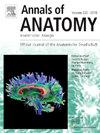Prone positioning improves surgical access to the thoracolumbar junction – An MRI pilot study
IF 2
3区 医学
Q2 ANATOMY & MORPHOLOGY
引用次数: 0
Abstract
Background
The lateral decubitus position is the standard position for a lateral approach of the thoracolumbar junction, but prone positioning has been observed to increase the distance of abdominal organs from the spine in comparison to lateral decubitus position and gives a safe exposure to the lumbar spine.
Purpose
To compare distances between the thoracolumbar spine junction and abdominal structures between lateral decubitus and prone position.
Methods
Magnetic resonance imaging was conducted in two positions, lateral decubitus and prone, in six volunteers with no previous spine injury or complaints. Distances of abdominal structures from the spine were measured from Th10 to S1.
Results
In lateral decubitus position, abdominal structures shifted away from the thoracolumbar junction on the left side but became nearer to the spine on the right side. The distance of abdominal structures from the spine was highest in prone position, particularly on the right side.
Conclusions
These anatomical descriptions suggest that prone position can improve surgical access to the thoracolumbar junction in comparison to the standard lateral decubitus position, from the right side as well as from the left side.
求助全文
约1分钟内获得全文
求助全文
来源期刊

Annals of Anatomy-Anatomischer Anzeiger
医学-解剖学与形态学
CiteScore
4.40
自引率
22.70%
发文量
137
审稿时长
33 days
期刊介绍:
Annals of Anatomy publish peer reviewed original articles as well as brief review articles. The journal is open to original papers covering a link between anatomy and areas such as
•molecular biology,
•cell biology
•reproductive biology
•immunobiology
•developmental biology, neurobiology
•embryology as well as
•neuroanatomy
•neuroimmunology
•clinical anatomy
•comparative anatomy
•modern imaging techniques
•evolution, and especially also
•aging
 求助内容:
求助内容: 应助结果提醒方式:
应助结果提醒方式:


